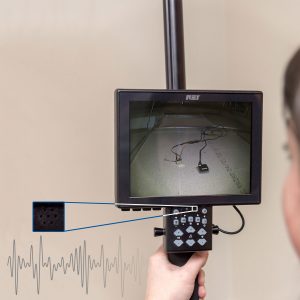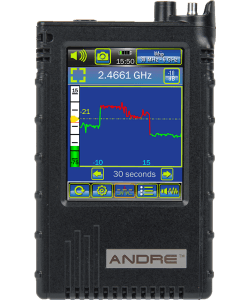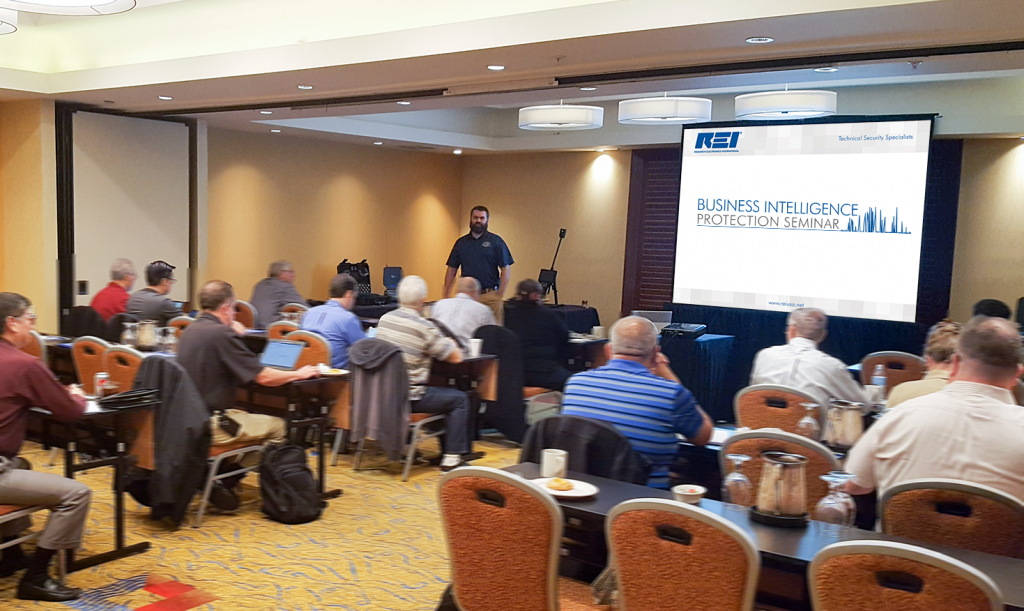 Not only can the VPC 2.0 capture video while in use, it also features a built-in microphone. This microphone adds the ability to provide voice descriptions of what the user is seeing. Pairing the audio along with the captured video provides essential context when reviewing the footage at a later time. Continue reading “Tech Note: Recording Audio with VPC 2.0”
Not only can the VPC 2.0 capture video while in use, it also features a built-in microphone. This microphone adds the ability to provide voice descriptions of what the user is seeing. Pairing the audio along with the captured video provides essential context when reviewing the footage at a later time. Continue reading “Tech Note: Recording Audio with VPC 2.0”
News & Announcements
REI’s Business Intelligence Protection Seminars explain the risks posed to businesses and individuals by electronic eavesdropping and illicit surveillance. Wrongful exposure of sensitive information including merger or acquisition planning, marketing strategies, financial projections, or executive employee behavior can severely harm an organization. The mere perception of compromised information can lead to stock decline, negative publicity, damaged business relationships, and loss of customer confidence. BIPS offer practical instruction and techniques to guard against critical information loss.
Recently a new OSCOR Firmware update was released on the REI website. This free download is available for the OSCOR Blue and OSCOR Green Spectrum Analyzers. In addition to performance improvements, two file and data operations have been added to the latest firmware.
Frequency Allocation Information
When generating a signal list, the OSCOR will automatically populate the comments field with information about the frequency band that a signal might be a part of for the currently selected ITU region. This information contains known regulatory or other uses of given frequency bands. Depending on the frequency there may be multiple allocations given. The frequency allocation information is also provided anytime that a signal is added to an existing signal list.
The TALAN is capable of detecting VoIP packets on VoIP phone systems using the 10/100 Mbps rate. The TALAN VoIP Test Adapter will force some Gigabit VoIP systems to auto-negotiate to the 10/100 Mbps rate. However, some VoIP network systems may not be fully compatible with the VoIP Test Adapter, or have been set up not to auto negotiate down. Below are compatibility issues that may be encountered and also solutions:
Continue reading “Testing Gigabit VoIP Systems with TALAN 3.0”
REI’s CPM-700 was the standard in RF broadband detection for over 20 years in the TSCM market. Now the ANDRE offers many more features to its users. The ANDRE includes robust tools to help identify what type of signals are being encountered and offers powerful post-sweep analysis functions not available in other broadband detectors.
HOW THE SIGNAL LIST WORKS
The ANDRE automatically generates a list of detected signals that exceed the designated trigger level and register on the frequency counter. These signals display from strongest initial RF level at the top to weakest at the bottom and can be customized to show 10, 25, 50, or 250 signals. Even when the signal list display is full, the ANDRE continues to capture weaker signal information. If a newly-detected signal is stronger than another in the list, the list automatically re-sorts and weaker signals roll off.
The newly-launched ANDRE Advanced Near-field Detection Receiver from Research Electronics International is helping prevent fraud at exam testing sites. Commonly used for counter surveillance operations and intelligence protection, the ANDRE is now also helping educators prevent cheating during examinations by detecting covert electronic transmissions.
According to news reports out of Brazil*, eleven individuals were arrested last year for using electronic devices during the high-profile National High School Examination (ENEM). This year, the Ministry of Education will be using ANDRE to locate and identify participants who attempt to use electronic devices during the exam and may have circumvented inspection by metal detectors.
Continue reading “Preventing Fraud at Exam Testing Sites Using the ANDRE”
 The newly-launched ANDRE Advanced Near-field Detection Receiver from Research Electronics International is helping prevent fraud at exam testing sites. Originally designed for counter surveillance operations and intelligence protection, the ANDRE is now also helping educators prevent cheating during examinations by detecting covert electronic transmissions.
The newly-launched ANDRE Advanced Near-field Detection Receiver from Research Electronics International is helping prevent fraud at exam testing sites. Originally designed for counter surveillance operations and intelligence protection, the ANDRE is now also helping educators prevent cheating during examinations by detecting covert electronic transmissions.
According to news reports out of Brazil*, eleven individuals were arrested last year for using electronic devices during the high-profile National High School Examination (Enem). This year, the Ministry of Education will be using ANDRE to locate and identify participants who attempt to use electronic devices during the exam who may have circumvented inspection by metal detectors.
REI will be hosting a one-day ANDRE training at REI headquarters in Tennessee. This one-day course will provide a thorough overview of the ANDRE’s functionality and several hands-on exercises in our dedicated project rooms.
November 16, 2017
8:30 AM – 4:30 PM CST
Cookeville, Tennessee USA
Register Now
In the previous REI newsletter we discussed the importance of spectrum analyzer mobility in order to locate transmitters. Detecting and identifying types of signals is very important, but locating transmitters is equally, if not more important if you want to find malicious surveillance devices, and that requires a portable receiver. Moving the spectrum analyzer reveals changes in signal amplitude as it gets closer or further away from a signal’s source.
Is your company evaluating how to protect its intellectual assets? An IBM-sponsored study reports that the average cost of a data breach is $3.62 million and the average size of data breaches is on the rise. Today’s existing internet and mobile phone networks serve as digital listening posts anywhere in the world. There are more frequent occurrences where technical security vulnerabilities are opening the door to cybersecurity threats:

